More info
Datasheet
| Minimum Tank Size | 60 litres / 15.85 US gallons |
| Maximum Size | 4.0cm / 1.57inches |
| Temperature | 20°C / 68.00°F - 24°C / 75.20°F |
| Hardness | 2.02dgH / 36ppm - 12.05dgH / 215ppm |
| pH | 6.0-7.5 |
Behaviour
Gastromyzon ctenocephalus is a very peaceful loach species, but its environmental requirements limit suitable tankmates. It is not recommended to house them with much larger, aggressive, territorial, or competitive fish. Potential tankmates include small cyprinids like Tanichthys, Danio, and Rasbora, stream-dwelling gobies such as Rhinogobius, Sicyopterus, and Stiphodon, and rheophilic catfish like Glyptothorax, Akysis, and Hara spp. They can also coexist with certain loaches from specific families. In captivity, observing their most interesting behavior is possible with a group of four or more individuals, as they are territorial to some extent, showing protective behavior over feeding spots.
Feeding and Diet
Gastromyzon ctenocephalus predominantly feeds on benthic algae and associated micro-organisms. In captivity, they accept quality dried foods, meatier items like bloodworms, and home-made foods bound with gelatin containing fresh vegetables and Spirulina. Maintaining a mature aquarium with algae-covered surfaces is crucial for their long-term health. In cases where the tank lacks sufficient algae, a separate nursery tank can be utilized to grow algae-covered rocks and rotate them periodically into the main tank. Ensuring a proper diet is vital as excessive protein intake can lead to internal problems for this species.
Reproduction & Dimorphism
For Gastromyzon ctenocephalus, successful breeding in aquaria has not been extensively documented. Observation of breeding behavior in the wild reveals that spawning can be induced through specific conditioning techniques, precise water temperature adjustments, and the presence of suitable spawning substrates combined with optimal water parameters. Sexual dimorphism is noticeable in adult females having a heavier body and being slightly larger than males. Male individuals display distinct patches of tubercules on their pectoral fins and head, a feature absent in females.
Habitat and Distribution
Endemic to western Borneo, Gastromyzon ctenocephalus is found in headwaters of the Sungai Sarawak in Sarawak State, Malaysia, and the Sungai Sambas in West Kalimantan Province, Indonesia. In its natural habitat, these loaches inhabit swift, shallow streams characterized by oxygen-rich, clear water. They prefer rocky substrates covered with algae and are typically found in shaded areas near riffles, runs, and cascades. Gastromyzon ctenocephalus coexists with various fish species like Gastromyzon ocellatus and G. stellatus in their native habitat.
Tank Setup
Creating a suitable aquarium environment for Gastromyzon ctenocephalus requires clean, well-oxygenated water with an over-sized filter providing 10-15 turnovers per hour. A substrate mix of gravel and sand, along with water-worn rocks, and aged driftwood is recommended. The tank should include areas for algae growth, like exposed filter sponges and adaptable aquatic plants. Stability in water conditions is crucial for the well-being of these loaches. Regular maintenance, including partial water changes, and promoting the growth of aufwuchs on tank surfaces are essential practices when caring for Gastromyzon ctenocephalus.

